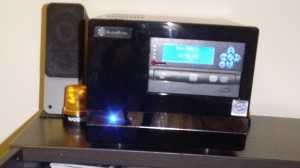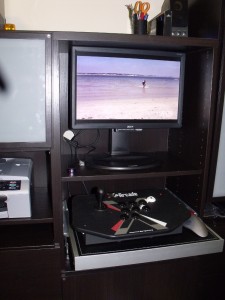 As the second part of our multipart series, Better Know a MythTV configuration, we profile one of our MythTV frontends.
As the second part of our multipart series, Better Know a MythTV configuration, we profile one of our MythTV frontends.
This is the newer of the two frontends we currently have in use. The case is a Silverstone Sugo SG-02, which looks rather nice in black. Inside, you can see a generic DVD drive and a CrystalFontz 20×4 LCD display that hooks into the internal USB headers on the Asus mainboard.
The processor is an Athlon X2 Dual Core BE-2400, the lowest power dual core available at the time of purchase, and rather inexpensive even then. The newest component is a NVidia GeForce 8400 series graphics card, which replaced an older video card. The card supports overloading of video decoding/playback under Linux, allowing a computer with little processing power to playback high definition video.
The hard drive is only used for the operating system, and happens to be one of the retired drives from the file server. A USB drive would work just as well, but would slow boot time. We could also have tried booting and loading data off of the network, but using an old drive to store the OS seemed simplest.
 The monitor is an Acer 22″ computer, not television monitor, with a maximum resolution of 1600×1200.
The monitor is an Acer 22″ computer, not television monitor, with a maximum resolution of 1600×1200.
One of the features that is unique to this frontend is the addition of the pullout X-Arcade Solo Controller, which slides in below the monitor when not in use. This system can also double as an arcade emulator, for the playing of classic arcade games. The monitor is even set to rotate to accommodate the portrait style screen of such a system, however when we put the system into its current cabinet, we didn’t account for the fact the monitor does not currently have enough clearance to rotate without being removed, a problem we have not bothered yet to solve.
We’re not big gamers, but we enjoy the nostalgia of playing the ones we played when we were young. MythTV includes a plugin/launcher for this.
The speakers are Creative Gigaworks T20 speakers, and do not offer a subwoofer. Our other system has full surround audio, but this one was designed to be much quieter, so we opted for a simpler speaker setup.
Finally, the remote is a simple Windows MCE infrared remote(not pictured). The system, when not in use, is turned off. It is plugged into a power strip(not pictured) with a master outlet, which shuts the power to the speakers and monitor when the computer turns off.
There have been other features/tweaks we have contemplated. for one, triggering the start of the computer with the remote, which we’ve run of but have been unable to get working. Like anything else, systems continue to improve.
The last major addition added Hulu Desktop for Linux into the Frontend, so it can be launched, control handed over to Hulu, then back to MythTV.
Next time, Part 3, the final backend.
Related articles by Zemanta
- MythTV Rig: Part 1 – The Backend (gadgetwisdom.com)


Blogging…: MythTV Rig: Part 2 – A Frontend http://bit.ly/dwQFzt
This comment was originally posted on Twitter